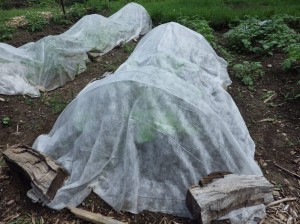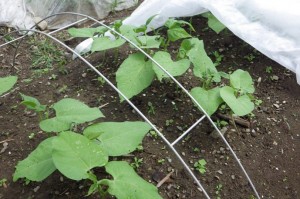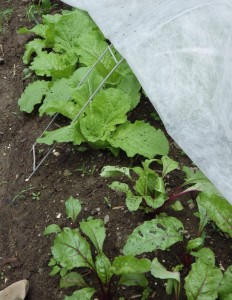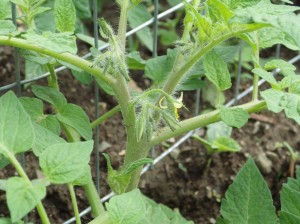 This is not a very exciting photo but it does give a pretty good indication of what, to the casual observer, is our garden this year. We got started late, got invaded by rabbits, got very little rain in late May and early June. So, to thwart the rabbits, at least until things like corn and the sunflowers are big enough to be able to withstand nibbling, I covered everything up with row cover. Row covers come in all sorts of weights, from ‘blankets’ which you can use early in the spring and late in the fall to withstand several degrees of frost to stuff that is basically see-through and which you use to thwart insects. What I’m using is sort of a midrange item; it does cut back on how much sunlight can come through but on the other hand, the rabbits can’t see through it to get any nasty ideas.
This is not a very exciting photo but it does give a pretty good indication of what, to the casual observer, is our garden this year. We got started late, got invaded by rabbits, got very little rain in late May and early June. So, to thwart the rabbits, at least until things like corn and the sunflowers are big enough to be able to withstand nibbling, I covered everything up with row cover. Row covers come in all sorts of weights, from ‘blankets’ which you can use early in the spring and late in the fall to withstand several degrees of frost to stuff that is basically see-through and which you use to thwart insects. What I’m using is sort of a midrange item; it does cut back on how much sunlight can come through but on the other hand, the rabbits can’t see through it to get any nasty ideas.
Yes, we could fence in the garden and one of these days, we’ll probably have to do that but for the moment, I like to just be able to walk into it.
And what is under that cover? Beans (which of course are one of the favorites of rabbits; at this rate, I might have to keep them covered most of the time until they flower and then ride shotgun on them for a few days until the bees can get to them). These are our usual, Royal Burgundy, because first, they are supposedly good for cold springs (which we had) and they have a nifty ability to notify you when you are cooking them as to whether or not they are done: Once harvested, clean, snap (or not) and throw into boiling water. As soon as the purple beans turn green, they are done! It’s so fast that basically you just stand there intently gazing at them and then pull them off the heat and drain as soon as they go from purple to green. No overcooking that way.
These are our usual, Royal Burgundy, because first, they are supposedly good for cold springs (which we had) and they have a nifty ability to notify you when you are cooking them as to whether or not they are done: Once harvested, clean, snap (or not) and throw into boiling water. As soon as the purple beans turn green, they are done! It’s so fast that basically you just stand there intently gazing at them and then pull them off the heat and drain as soon as they go from purple to green. No overcooking that way.
What else have we got going?
Well, next door to the green beans (and actually all of these beds are mixed. The green beans are snuggled up against potatoes and a couple of extra cauliflower plants that needed a home) is this bed, under cover as well.  What you are seeing in this photo are, at the front, beets. If we were growing chard, it would basically look exactly the same, except that chard just grows big leaves and stems(which is the business end of the plant), whereas with beets, you can thin out the younger plants and eat the stems and leaves (beet greens) and then leave the other plants to mature – they grow the bulbous root, which we all know as ‘beets’. Beets are great and full of nutrition, as is chard – they are from the same family. The plus side of beets though is that you can roast the roots which make for terrific eating.
What you are seeing in this photo are, at the front, beets. If we were growing chard, it would basically look exactly the same, except that chard just grows big leaves and stems(which is the business end of the plant), whereas with beets, you can thin out the younger plants and eat the stems and leaves (beet greens) and then leave the other plants to mature – they grow the bulbous root, which we all know as ‘beets’. Beets are great and full of nutrition, as is chard – they are from the same family. The plus side of beets though is that you can roast the roots which make for terrific eating.
At the back of the photo are Chinese cabbages. There are a zillion items which are referred to as ‘Chinese cabbages’, including bok choi, pe stoi, and on, but these are supposedly miniature Napa type cabbages, which we plan to harvest and use to make the Korean fermented cabbage, ‘kimchi’. One of the other reasons why I covered up this row (which also includes broccoli, kale and cauliflower) is that there is a lovely cute little white moth, which is attracted by the sulfur compounds emitted by members of the cabbage family. The moth deposits its little green eggs on the plants and when they turn into little green caterpillers, they go to town, eating holes through everything. Not that I am averse to pulling out little green wiggly things out of my broccoli, but sometimes you miss one and… well, it gets a little bit ugly later once it’s on the plate. Yes, there are horrible chemicals you can use to theoretically protect the plants, but frankly, I’m cheap and it’s easier to use row covers (they last for several years) and avoid having to spray that stuff multiple times over the growing season, or keep track of how many times you did it, when you did it and so on. Just keep the plants covered. Easy as pie.
Other items in the garden which are doing their thing (and as soon as it stops raining –we’ve already gotten about 2.5″ of rain this week – it’s starting to look like a swamp out there — I’m sure they will take off) are potatoes, winter and summer squashes, cucumbers, several types of melons, peppers, sunflowers and a heritage varity of corn called “Bloody Butcher” ( I could not resist that).
I also grew three different varieties of tomatoes.
 We are trying a couple of experiments this summer: Two different paste varieties and a new organic one out of Cornell University called “Iron Lady” which was selected for resistance to early and late blight. Given what’s happened with the weather this spring (cold, then dry, then wet), I figure that if I’m going to get tomatoes this year, I’m going to need to hedge my bets there as well as the long range weather folks are saying that we will not get true tomato growing weather until August.
We are trying a couple of experiments this summer: Two different paste varieties and a new organic one out of Cornell University called “Iron Lady” which was selected for resistance to early and late blight. Given what’s happened with the weather this spring (cold, then dry, then wet), I figure that if I’m going to get tomatoes this year, I’m going to need to hedge my bets there as well as the long range weather folks are saying that we will not get true tomato growing weather until August.
This photo is of one of the paste varieties (it might be Roma or it might be San Marzano) and as you can see, it has flowers already. One of the things I did not notice (you’d think I would, but) is that both of these varieties are what is referred to as ‘determinant’ tomatoes (versus ‘indeterminant’ tomatoes). So, what is the difference?
Determinant tomatoes are those which frankly mature most of their crop at the same time, which makes it great for varieties which you’d use for canning or freezing. They also tend to be shorter and stockier plants and do not ramble. So, if you are the sort of person who ‘desuckers’ your tomatoes (that is, breaks off all the little shoots that grow between the stem and the leaves), then you don’t want to do that. Determinant tomatoes have a definite production capacity and that includes all the leaves and stems and branches it has. If you take off any of the little stems, then you are lowering the production capacity of the plant. So, with determinant tomatoes, just stick them in the ground, put on a cage or support and that’s it. “Indeterminate’ tomatoes are the ones that a) you’ll want to ‘desucker’ and b) have the biggest, strongest supports you can get because they will just keep growing and growing, no matter what stage of the cycle they are in. They will literally have red tomatoes, unripe green tomatoes and maybe even some flowers on them and they will keep right on growing on the plant side until they are killed by frost (or blight or something else). What many gardeners do, then is, as I said before, they desucker them, basically training them to one central stem and tie that to some sort of support. We’re using heavy wire fencing this year to see if this works better with the “Iron Lady’ tomatoes, as I absolutely hate it when we get into the production season and the tomato cages (no matter how heavy they are) just keel over with the load of the plant and the tomatoes, leaving things on the ground where no one can find the tomatoes and they end up rotting.
Something else some gardeners do is try to fool the plant into thinking that they’ve been hit by the frost. The way they do this is to pinch out or cut the every ends of the growing branches on these tomatoes. The plant will take this as a signal that winter is coming and since tomatoes are annuals they will throw out the chemical signals to the tomato fruits themselves to ‘get ripe, right NOW.’ I’m not sure this is a technique that you can use with determinant tomatoes also, but it will work with the indeterminate ones. On the other side, once you’ve got your tomato desuckered and set up, don’t start pruning it or anything because this will send the same signal; only use this technique late in the season when the plants have a load of green tomatoes on them and you want to ripen them up all at once. Once the plant has done that and you’ve harvested the tomatoes, it’s done for the year. Pull it out.
How are your gardens doing this year?
